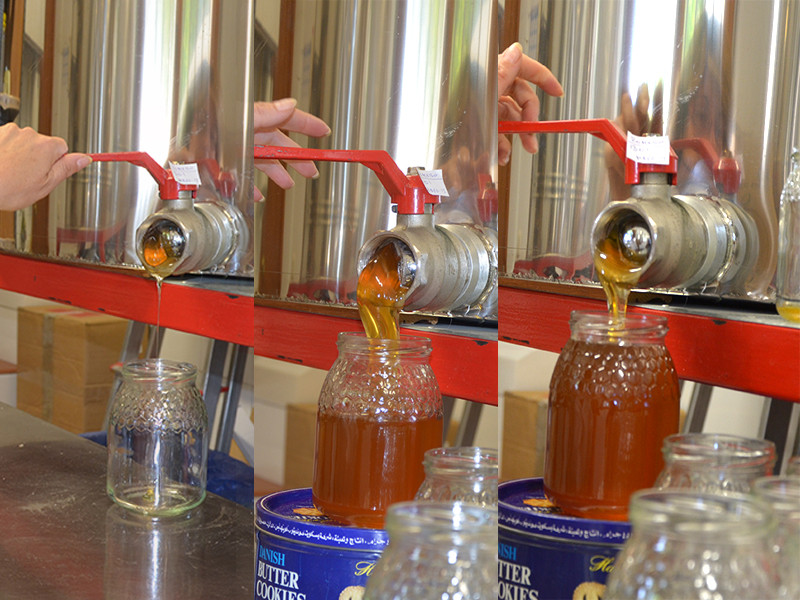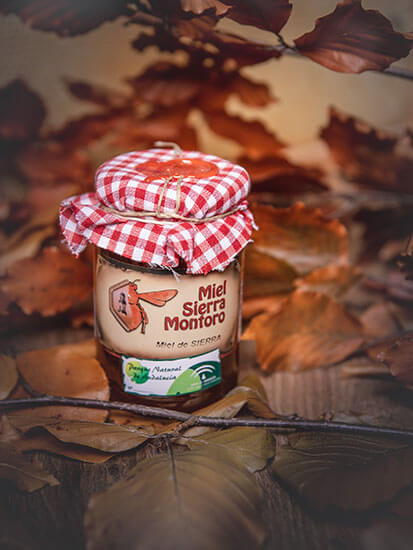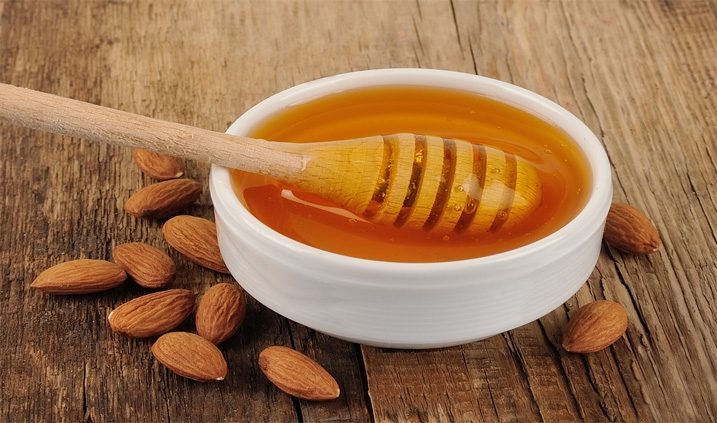Unpasteurized raw honey
Unpasteurised honey is honey that has not been subjected to a thermal process to break its glucose crystals. Processes that commercial honeys undergo, to ensure that the honeys are always liquid but that they take most of their benefits along the way. Therefore, it is the raw honey without pasteurization, it is the purest and highest quality honey. A product that comes directly from nature, without any living being dying on the way, and which we are going to show you in depth. Furthermore, unpasteurized honey is one of the products that you must have always in your home.
Index of the article:
|
Summary: Honey is a fantastic natural product but very easy to manipulate. Therefore, here we explain and give advice to you so that you know how to differentiate a quality raw honey and the difficulties to detect the frauds that are carried out around the world. We also see some characteristics of raw honeys. Finally, in our shop in Las Rozas de Madrid they have a fantastic selection of top quality honeys (lavender, heather, rosemary, thyme, eucalyptus…)
Other related items: Where to buy quality raw honey. Honey is fattening, myth or reality? Flowers for honey. The 5 best honeys in the world. History, bees and pollination. The adulteration of honey, the absorbent resin. The bees, their honey and curiosities. Honey labelling. The 7 rarest honeys in the world. The most expensive honeys in the world.
1. What is real honey? and unpasteurized honey?
Crystallization, a natural phenomenon, in which raw and unpasteurized honey turns from a liquid to a semi-solid state. This change of structure is a change of state where the molecules of honey, mainly glucose, lose energy and release it as heat. This process takes place at a faster rate in lighter honeys than in darker honeys, because lighter honeys contain a higher content of glucose, which is the sugar that first crystallizes. However, there are exceptions, such as Acacia honey, which is very clear and takes a very long time to crystallize or never crystallize.
The crystallization of honey is accelerated with temperatures close to 14°C, remains of propolis, micro air bubbles, pollen, wax residues, etc. On the contrary, high contents and lower glucose proportions slow down crystallization.
With the crystallization process, raw honey starts to change in color and texture, but without any loss of flavor, aroma or properties. This process is completely natural and happens to any high quality honey.
Video 1: Honey extraction
a) Honey extraction process
Once the honey has been extracted from the honeycomb and collected, it is stored in stainless steel tanks. However, with ttime high quality honey tends to solidify, that is, crystallize. For this reason, to be able to pack the honey, when the honey is crystallized, the packer have to increase the temperature of honey of about 40°C, so he can return it back to its liquid state. In this way, in this state is easy to pack in bottles. Imagine how difficult it would be to pack solid honey in the smallest crystallized jars, the beekeeper would spend a lot of time on packaging.
By subjecting the honey to these not very high temperatures, 40 ºC, the properties of the raw honey are hardly damaged, so it still keeps its taste and aroma intact. However, for lovers of the most natural, you can also buy honey with the honeycomb included, this is a product that has only been handled by bees, man does not even touch it.

Photo 1: Unpasteurized honey not yet extracted
b) Crystallization in its packaging
Once the raw and unpasteurized honey is packaged in an airtight container and takes normally the room temperature. Here, the honey starts to become cloudy, beginning right now its crystallization process in the jar. This process is slower in summer because of the higher temperatures and is faster in winter with cooler temperatures. At higher temperatures, the opposite process also occurs; the crystallized honey becomes liquid when taking the heat from the environment.
With crystallization, a more or less thick, white, dusty film or layer may appear on the honey, consisting mainly of glucose crystals on the top of the jar and on the honey in contact with the glass. Over time, the crystallization process continues until the entire pot hardens.
In winter, if you buy raw honeys, they may be solidified or in the process of solidifying, and in summer with higher temperatures, the honey remains in a liquid state for longer, or decrystallizes if it passes from a solid to a liquid state.
With decrystallization, the honey can soften and form two phases. First the glucose enriched crystals, due to their greater weight, descend to the bottom of the container, and the solution enriched with levulose, of a dark colour, rises upwards. At this point, the honey is at risk of fermentation. Fermentation is not harmful to health, but it would give honey strange tastes and smells.

Picture 2: Raw unpasteurized honey packaging
2. How do you differentiate between pure and raw quality honey?
Really, natural raw honey should not be given any surname, because according to the RAE (Royal Academy of the Spanish Language), honey is: “a food that comes from nectar and is transformed by bees in their stomach”. However, honey on the market is manipulated and even additives are added. This process is not harmful to health, but if you buy honey and it is no real honey, consumer are misleaded.
Therefore, one must know the characteristics that a quality honey has and know how to distinguish it from an adulterated honey. However, unfortunately, this is not easy in the vast majority of cases. In cruder adulterations, it may be easier, but in the adulterations we find on the market, this can only be done with laboratory analysis. Analyses, by the way, are expensive and almost nobody does them.
However, taking into account a number of factors and facts, it is easy to find quality honeys and get away from adulterations.
These are the points and information you need to buy quality raw honey.

Photo 3: unpasteurized honey from Sierra Montoro
a) What is a quality raw honey?
A quality honey have always to be raw and not pasteurised, i.e. it must be solidified or tend to solidify. This would be the first step in buying a quality honey. All honeys that are liquid and never solidify in the cold indicate that the honey is not quality. As a consequence, they are honeys that have been pasteurised, i.e. subjected to high temperatures where they lose their enzymes and vitamins.
These statements should be made clear, as dark honeys: heather, holm oak and forest honeys, take a long time to solidify. If these honeys coincide with the summer season, they can be liquid, even if they are of good quality. Another exceptional case is acacia honey, which takes years to crystallize. On the other hand, at the other end is rosemary and orange blossom honey, which takes very little time to crystallize.
Other fundamental characteristics of a quality honey are its floral aromas and fruity flavours when savoured. A honey that neither tastes nor smells, makes it clear that it has been adulterated.
b) Differences between raw and regular honey
As we have indicated, raw honey is a real honey directo from the beehive. In the case of cooked honey, which is a new concept being introduced, it is the honey that has been pasteurised. Consequently, regular honey is a honey with much less flavour and fewer health properties.
3. Unpasteurised organic honey
Many beekeepers for economic reasons do not label their honeys as organic honey although they would easily pass these checks. As well, it is true that organic raw honey is of enormous quality and has passed rigorous quality controls. However, it is also true that if we buy the honey directly from a beekeeper, we can be very sure of its quality and that it does not contain any traces of antibiotics and agrichemicals. We have to keep in mind, that the use of antibiotics in beekeeping is very controlled, and they cannot be used indiscriminately.
On the other hand, organic honeys that have been pasteurised and are not raw, do not make much sense in my opinion. A honey that is organic but has been pasteurised has lost many of its properties. If we have to choose between a pasteurised organic honey and a non-organic raw honey, I would always recommend choosing the raw one. Because no pasteurized honey is the healthiest honey.
a) Pasteurisation
Pasteurisation of honey consists in heating the honey to high temperatures of about 78°C for six or seven minutes, then rapidly cooling it down. This process kills yeasts, melts glucose crystals, (let’s remember that these are the culprits of crystallization). At the same time, it wipe their enzymes, vitamins, antioxidants and other antibacterial components. Pasteurisation therefore delays the crystallisation of the honey, but at the same time destroys a large part of its organoleptic, healthy and curative properties.
Furthermore, by destroying the yeast, the honey is prevented from fermenting. However, packaging companies also take advantage of this process to further adjust the humidity limits set by law. Also, water can be added to increase the profitability of the honey. A quality honey with a low water content is watered down, and in this way we can get more honey.
In summary, pasteurisation destroys the delicate and pleasant flavours that are hidden in each variety of raw honey. It is also responsible for destroying enzymes that prevent bees from being responsible for the activation of vitamins.

Photo 4: Quote abot bees
4. Methods for analysing the quality of honey
Honey is one of the most manipulated products on the market. Since it is very easy to mix honey with other low quality or non-honey sources. This causes enormous damage to beekeepers, small and medium sized packers and honey shops.
However, there are parameters to detect these fraudulent practices, which are the following:
- Pollen analysis
- Physico-chemical analysis
- Sensory analysis
Unfortunately, all of them are expensive. For this reason, usually they are not made.
a) Origin of honey pollen
First of all, if we know the origin of the honey, which flowers the bees have visited, and if we contrast these sources with a geographical location, we can detect whether the honey has been adulterated. This can be known by analysing the origin of the pollen. Therefore, this is achieved with a mesopotamian analysis.
Likewise, the ultra-filtration of honey is a practice carried out to hide the origin of the honey. This process consists of heating the honey to very high temperatures and then passing it through very fine filters. As a result, the pollen is retained in these very fine pore filters and the pollen is removed from the honey.
However, once the honey has gone through this process, it should already be called honey. Because the high temperatures, and the removal pollen of the honey, end up with most of the beneficial properties of the honey. Therefore, this is turning honey into a simple sweetener.
b) Honey pollen variety
Bees, like other animals, need a varied and balanced diet. Therefore they need a varied source of pollen. This will strengthen their immune system and be less sensitive to disease.
5. Honey States
Raw honey can be presented in three different states:
a) Liquid state
The honey is made in liquid form by the bees, and it is crystallised later inside the cells. To remove it from the cells and to bottle it, the beekeepers heat the honey slightly, above about 40 ºC, and in this way they can extract and bottle it. Once the honey has been bottled, depending on the type of honey and other factors, it goes into a solid state agian.
The consumer can also turn the honey into a liquid state by heating it. We recommend to do it by bain-marie.
b) Creamy state
The creamy state that is not easily found in Spain, is very useful for spreading on toast. Also, from a commercial point of view, probably its is the most atractive state.
The creamy state is obtained from the liquid state. This creamy state can be achieved in different ways, one more natural and other more industrial
- Mechanical method:
This state can be achieved by the beekeeper or packer by controlling and directing the crystallization. At the same time, a mechanical system beats the honey until it reaches this creamy state.
- Induced crystallization method:
In this method the liquid honey is mixed with 10 or 20% of ground honey crystals, achieving this creamy texture.
c) Solid state
The solid state is the natural state of honey in its least energetic form. All quality honey, if left alone in a cool place naturally tends to this state.
Video 2: Our beekeeper Jesús Moreno
Freezing point
When we lower the temperature of the honey, it becomes thicker and less viscous. From -20°C onwards, the honey becomes more solid although it still maintains its fluidity, and it is at this temperature that we could say that the honey is frozen. However, contrary to what one might think, lowering the temperature of the honey slows down the crystallisation of the honey.
As honey has a very low moisture content, its melting point is very low, as the melting point of pure water is 0 ºC.
Likewise, if we lower the unpasteurised honey to such low temperatures, the honey does not lose any properties.
6. Dangers of raw honey
The dangers of unpasteurised honey if the beekeeper has his facilities in optimal conditions are nil. This is not the case with honeys that are stored or packaged in places that do not have adequate cleaning conditions. These honeys could store bacteria spores, like bacteria Clostridium botulinum. Later, these can develop and create a very serious infection in the person.
For this reason, we must consume raw honey of quality from reliable beekeepers. We have visited all our beekeepers and asked for their health records. In this way we ensure the highest quality and food safety of the honeys. In addition, all of them pass state veterinary checks.
a) Poisonous honey
There are some types of honey that can have poisonous components, which can cause vomiting, nausea, headaches and even unconsciousness. Also, in the most extreme case, they may contain spores of the “Clostridium botulinum” bacteria, which will kill you.

Photo 5: Flowers of Madrid
7. How to re-liquefy crystalized honey?
Easy methods to turn crystallized honey back to liquid form!:
a) Bain Marie
If we have unpasteurized honey in a solid state and we want it to be liquid, the best method is to put it in a bain-marie. To put it in a bain-marie we must do the following:
First, we must put it in a big container, like a casserole, with water in the inside. Later place the glass jar inside of the container with woter. If you have the honey in a plastic or ceramic jar, you should always put the honey in a glass jar, where you will do a bain Marie.
Secondly, once the honey has taken temperature, we must stir the honey until it becomes completely liquid. Keep in mind that this method is slow, but this way it will not damage the properties of the honey.
You should also know, that if you store this honey in a cool place, the honey will return to its solid state rapidly. How quickly this happens will depend on the temperature approaching 14 degrees and the type of honey.
c) Honey Heaters
In the market there are deposits that heat the unpasteurized honey, and so it remains in its liquid state for longer time. However, these heaters are large in size and are designed for beekeepers and packers.
d) What should we not do?
What we should not do, is to put the honey in the microwave, since it will load properties of the honey.
On the Internet, we have found another way, which is a little strange, to go into liquid form, is to put unpasteurized honey in the dishwasher. This method seems a bit strange to me. Furthermore, we don’t recommend it either, because water could get into the honey and besides. Also, it would take very high temperatures that would eliminate properties of the honey.

Photo 6: Valderromero’s Thousand Flower unpasteurized Honey
8. Defense of quality unpasteurized honey
Currently in Spain and the vast majority of European countries, the labelling of honey is highly fraudulent. It is possible to buy honey from other countries, such as Asian countries, which, as many references say, sell an industrially produced substitute, and package it as honey of European and non-European origin.
As in all cases, this allows us to defend the fraudster and facilitate the fraud. At the same time, honest beekeepers who sell 100 percent qualityunpasteurized honey are being shaken down. There is also a market, where honeys or honey substitutes are bought from a single source, and end up being labelled as of European origin.
The European Union should therefore properly label unpasteurised European honey and not allow packers to mix national honeys with honeys of dubious origins. At least, if this is done, it should be reflected on the label and people should know what they are buying.
Source:
Website about Information of unpasteurized Honey







Properties of natural honey.thanks for post
thanks